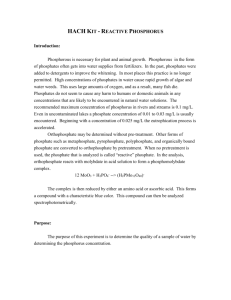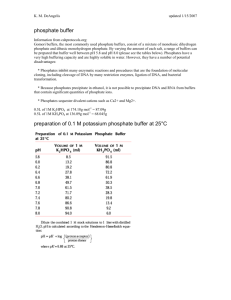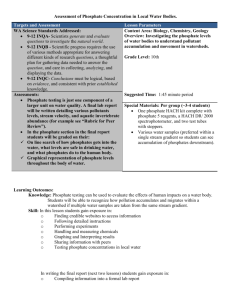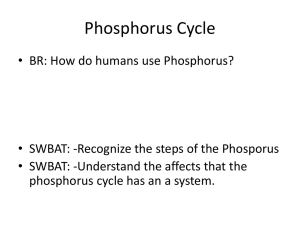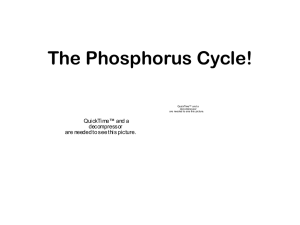phosphate - ES-Emerald(2010
advertisement
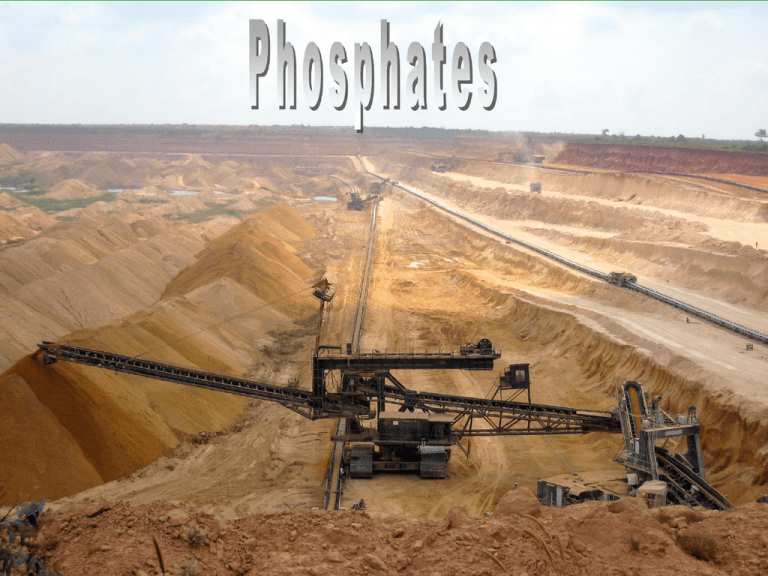
Phosphates A phosphate, an inorganic chemical, is a salt of phosphoric acid. In organic chemistry, a phosphate, or organophosphate, is an ester of phosphoric acid. Organic phosphates are important in biochemistry and biogeochemistry or ecology. Inorganic phosphates are mined to obtain phosphorus for use in agriculture and industry. At elevated temperatures in the solid state, phosphates can condense to form pyrophosphates. History of Phosphates According to author Arthur Toy, elemental phosphorus was discovered accidentally in 1669 while an impoverished German chemist was trying to make gold. Today phosphorus is an important part of many of the products that are indispensable to modern living and good health. Geochemistry of Phosphates Phosphates are the naturally occurring form of the element phosphorus, found in many phosphate minerals. In mineralogy and geology, phosphate refers to a rock or ore containing phosphate ions. Inorganic phosphates are mined to obtain phosphorus for use in agriculture and industry. The largest phosphorite or rock phosphate deposits in North America lie in the Bone Valley region of central Florida, United States, the Soda Springs region of Idaho, and the coast of North Carolina. Smaller deposits are located in Montana, Tennessee, Georgia and South Carolina near Charleston along Ashley Phosphate road. The small island nation of Nauru and its neighbor Banaba Island, which used to have massive phosphate deposits of the best quality, have been mined excessively. Rock phosphate can also be found in Egypt, Israel, Morocco, Navassa Island, Tunisia, Togo and Jordan, countries that have large phosphate mining industries. Ecology of Phosphates In ecological terms, because of its important role in biological systems, phosphate is a highly sought after resource. Once used, it is often a limiting nutrient in environments, and its availability may govern the rate of growth of organisms. This is generally true of freshwater environments, whereas nitrogen is more often the limiting nutrient in marine (seawater) environments. Addition of high levels of phosphate to environments and to micro-environments in which it is typically rare can have significant ecological consequences. For example, blooms in the populations of some organisms at the expense of others, and the collapse of populations deprived of resources such as oxygen can occur. In the context of pollution, phosphates are one component of total dissolved solids, a major indicator of water quality. Ecology of Phosphates Although phosphorus is a naturally occurring nutrient, human impacts have increased its availability Most waste water treatment plants cannot take phosphorus out of the water Chemical Properties The phosphate ion is a polyatomic ion with the empirical formula PO3−4 and a molar mass of 94.973 g/mol. It consists of one central phosphorus atom surrounded by four oxygen atoms in a tetrahedral arrangement. The phosphate ion carries a negative three formal charge and is the conjugate base of the hydrogen phosphate ion, HPO2−4, which is the conjugate base of H2PO−4, the dihydrogen phosphate ion, which in turn is the conjugate base of H3PO4, phosphoric acid. It is a hypervalent molecule (the phosphorus atom has 10 electrons in its valence shell). Phosphate is also an organophosphorus compound with the formula OP(OR)3. A phosphate salt forms when a positively-charged ion attaches to the negativelycharged oxygen atoms of the ion, forming an ionic compound. Many phosphates are not soluble in water at standard temperature and pressure. The sodium, potassium, rubidium, caesium and ammonium phosphates are all water soluble. Most other phosphates are only slightly soluble or are insoluble in water. As a rule, the hydrogen and dihydrogen phosphates are slightly more soluble than the corresponding phosphates. The pyrophosphates are mostly water soluble. PHOSPHATES IN EVERYDAY LIVING Phosphorus is a nutrient vital to human, animal, and plant life. It is one of the most common substances in our environment, naturally occurring in our food, our water and our bodies. In your body, phosphorus is present in your genes, your teeth, and your bones -- even your muscles work because of the phosphorus in adenosine triphosphate. 1. Phosphoric acid-based chemical polishes are used primarily to chemically polish (brighten) aluminum and aluminum alloys. 2. Many phosphorus-containing materials are used as flameretardants for textiles, plastics, coatings, paper, sealants and mastics. 3. "Phosphates and phosphoric acid have many uses in the treatment of potable (drinking) water. 4. Cleaning solutions with phosphates help clean mildew and stubborn stains on vinyl siding. There are a few characteristics that define phosphate properties, mainly molecular structure and pH (generally in a 1% solution). These determine the functionality of phosphates that in turn determine how the phosphates are used. They contribute buffering strength, sequestering (or chelating) power, dispersion and absorptive capabilities, and solubility. Phosphates are usually used as compounds of phosphate ions in combination with one or more common elements, such as sodium, calcium, potassium, and aluminum. They also offer benefits as nutrient sources. Phosphates are classified into several primary groups based on the number of phosphorus (P) atoms. Each of these groups have functional properties ideal for many applications. Orthophosphates Buffering - detergents, baking Pyrophosphates Sequestering - water treatment, metal cleaning Tripolyphosphates Dispersant - meat processing, dish detergent Polyphosphates Dispersant - kaolin production, processed cheese Number of P Atoms Ion Usual Name 1 PO4-3 Orthophosphates 2 P2O7-4 Pyrophosphates 3 p3O10-5 Tripolyphosphates >3 PnO(3n+1)-(n+2) Polyphosphates Phosphate products are a significant part of everyday living. In addition to their versatility, government authorities also recognize them as safe for worker exposure and handling and for use in the home. In addition to their versatility, phosphates are recognized by government authorities as safe for worker exposure and handling and for use in the home. In many water bodies, phosphorus is the limiting nutrient and controlling its level is an important step in preventing eutrophication. In most areas, most of the phosphorus comes from the environment itself, and only a fraction (about a third) from consumer products. Phosphates are important in our daily lives, as well as in Geology, Chemistry, etc. We should use it properly, don’t abuse the use of it for it will cause us more than the money we used to get it
